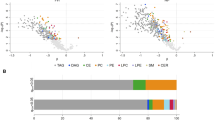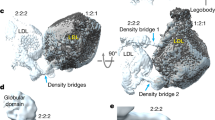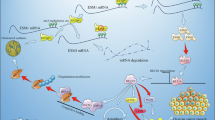Abstract
Ovarian cancer presents a significant treatment challenge due to its insidious nature and high malignancy. As autophagy is a vital cellular process for maintaining homeostasis, targeting the autophagic pathway has emerged as an avenue for cancer therapy. In the present study, we identify apolipoprotein B100 (ApoB100), a key modulator of lipid metabolism, as a potential prognostic biomarker of ovarian cancer. ApoB100 functioned as a tumor suppressor in ovarian cancer, and the knockdown of ApoB100 promoted ovarian cancer progression in vivo. Moreover, ApoB100 blocked autophagic flux, which was dependent on interfering with the lipid accumulation/endoplasmic reticulum (ER) stress axis. The effects of LFG-500, a novel synthetic flavonoid, on ApoB100 induction were confirmed using proteomics and lipidomics analyses. Herein, LFG-500 induced lipid accumulation and ER stress and subsequently blocked autophagy by upregulating ApoB100. Moreover, data from in vivo experiments further demonstrated that ApoB100, as well as the induction of the lipid/ER stress axis and subsequent blockade of autophagy, were responsible for the anti-tumor effects of LFG-500 on ovarian cancer. Hence, our findings support that ApoB100 is a feasible target of ovarian cancer associated with lipid-regulated autophagy and provide evidence for using LFG-500 for ovarian cancer treatment.
This is a preview of subscription content, access via your institution
Access options
Subscribe to this journal
Receive 12 print issues and online access
$259.00 per year
only $21.58 per issue
Buy this article
- Purchase on SpringerLink
- Instant access to full article PDF
Prices may be subject to local taxes which are calculated during checkout










Similar content being viewed by others
References
Siegel RL, Miller KD, Wagle NS, Jemal A. Cancer statistics, 2023. CA Cancer J Clin. 2023;73:17–48.
Sung H, Ferlay J, Siegel RL, Laversanne M, Soerjomataram I, Jemal A, et al. Global Cancer Statistics 2020: GLOBOCAN Estimates of Incidence and Mortality Worldwide for 36 Cancers in 185 Countries. CA Cancer J Clin. 2021;71:209–49.
Torre LA, Trabert B, DeSantis CE, Miller KD, Samimi G, Runowicz CD, et al. Ovarian cancer statistics, 2018. CA Cancer J Clin. 2018;68:284–96.
Burger RA, Brady MF, Bookman MA, Fleming GF, Monk BJ, Huang H, et al. Incorporation of bevacizumab in the primary treatment of ovarian cancer. N Engl J Med. 2011;365:2473–83.
Hanker LC, Loibl S, Burchardi N, Pfisterer J, Meier W, Pujade-Lauraine E, et al. The impact of second to sixth line therapy on survival of relapsed ovarian cancer after primary taxane/platinum-based therapy. Ann Oncol. 2012;23:2605–12.
Zhao S, Wang S, Cao L, Zeng H, Lin S, Lin Z, et al. Acupuncture promotes nerve repair through the benign regulation of mTOR-mediated neuronal autophagy in traumatic brain injury rats. CNS Neurosci Ther. 2023;29:458–70.
Zheng Y, Chen Z, Gu Z, Yang X, Yu M, Zhao C, et al. Starvation-induced autophagy is up-regulated via ROS-mediated ClC-3 chloride channel activation in the nasopharyngeal carcinoma cell line CNE-2Z. Biochem J. 2019;476:1323–33.
Allen EA, Baehrecke EH. Autophagy in animal development. Cell Death Differ. 2020;27:903–18.
Levine B, Kroemer G. Biological functions of autophagy genes: a disease perspective. Cell. 2019;176:11–42.
Mizushima N, Komatsu M. Autophagy: renovation of cells and tissues. Cell. 2011;147:728–41.
Duan WJ, Liu FL, He RR, Yuan WL, Li YF, Tsoi B, et al. Autophagy is involved in the effects of resveratrol on prevention of splenocyte apoptosis caused by oxidative stress in restrained mice. Mol Nutr Food Res. 2013;57:1145–57.
Yao J, Tang S, Shi C, Lin Y, Ge L, Chen Q, et al. Isoginkgetin, a potential CDK6 inhibitor, suppresses SLC2A1/GLUT1 enhancer activity to induce AMPK-ULK1-mediated cytotoxic autophagy in hepatocellular carcinoma. Autophagy. 2023;19:1221–38.
Yang J, Li ZD, Hou CY, Li ZY, Li Q, Miao SY, et al. EM-2 inhibited autophagy and promoted G2/M phase arrest and apoptosis by activating the JNK pathway in hepatocellular carcinoma cells. Acta Pharmacol Sin. 2021;42:1139–49.
Kocaturk NM, Akkoc Y, Kig C, Bayraktar O, Gozuacik D, Kutlu O. Autophagy as a molecular target for cancer treatment. Eur J Pharm Sci. 2019;134:116–37.
Limpert AS, Lambert LJ, Bakas NA, Bata N, Brun SN, Shaw RJ, et al. Autophagy in cancer: regulation by small molecules. Trends Pharmacol Sci. 2018;39:1021–32.
Fernández LP, Gómez de Cedrón M, Ramírez de Molina A. Alterations of lipid metabolism in cancer: implications in prognosis and treatment. Front Oncol. 2020;10:577420.
Prendeville H, Lynch L. Diet, lipids, and antitumor immunity. Cell Mol Immunol. 2022;19:432–44.
Yoon H, Shaw JL, Haigis MC, Greka A. Lipid metabolism in sickness and in health: Emerging regulators of lipotoxicity. Mol Cell. 2021;81:3708–30.
Rudalska R, Zender L, Dauch D. Exploiting lipotoxicity for the treatment of liver cancer. Br J Cancer. 2021;125:1459–61.
Lv S, Geng X, Yun HJ, Ding Y. Phenothiazines reduced autophagy in ischemic stroke through endoplasmic reticulum (ER) stress-associated PERK-eIF2α pathway. Exp Neurol. 2023;369:114524.
Fu X, Zhao W, Li K, Zhou J, Chen X. Cryptotanshinone inhibits the growth of HCT116 colorectal cancer cells through endoplasmic reticulum stress-mediated autophagy. Front Pharmacol. 2021;12:653232.
Choi YK, Kang JI, Han S, Kim YR, Jo J, Kang YW, et al. L-ascorbic acid inhibits breast cancer growth by inducing IRE/JNK/CHOP-related endoplasmic reticulum stress-mediated p62/SQSTM1 accumulation in the nucleus. Nutrients. 2020;12:1351.
Gugliucci A. Triglyceride-rich lipoprotein metabolism: key regulators of their flux. J Clin Med. 2023;12:4399.
Behbodikhah J, Ahmed S, Elyasi A, Kasselman LJ, De Leon J, Glass AD, et al. Apolipoprotein B and cardiovascular disease: biomarker and potential therapeutic target. Metabolites. 2021;11:690.
Gaglione R, Pizzo E, Notomista E, de la Fuente-Nunez C, Arciello A. Host defence cryptides from human apolipoproteins: applications in medicinal chemistry. Curr Top Med Chem. 2020;20:1324–37.
Su Q, Tsai J, Xu E, Qiu W, Bereczki E, Santha M, et al. Apolipoprotein B100 acts as a molecular link between lipid-induced endoplasmic reticulum stress and hepatic insulin resistance. Hepatology. 2009;50:77–84.
Wang B, Chao S, Guo B. Integrated weighted gene co-expression network analysis reveals biomarkers associated with prognosis of high-grade serous ovarian cancer. J Clin Lab Anal. 2022;36:e24165.
Yang D, Cao X, Wang F, Jiang H, Feng D, Guo H, et al. LFG-500, a novel synthetic flavonoid, suppresses epithelial–mesenchymal transition in human lung adenocarcinoma cells by inhibiting NLRP3 in inflammatory microenvironment. Cancer Lett. 2017;400:137–48.
Li CL, Li J, Gong SY, Huang M, Li R, Xiong GX, et al. Targeting the ILK/YAP axis by LFG-500 blocks epithelial–mesenchymal transition and metastasis. Acta Pharmacol Sin. 2021;42:1847–59.
Yin Z, Zhao X, Yang D, Cao X, Yu Y, Jiang H, et al. LFG-500, a newly synthesized flavonoid, induces apoptosis in human ovarian carcinoma SKOV3 cells with involvement of the reactive oxygen species-mitochondria pathway. Exp Ther Med. 2017;13:2819–27.
Oberg HH, Peters C, Kabelitz D, Wesch D. Real-time cell analysis (RTCA) to measure killer cell activity against adherent tumor cells in vitro. Methods Enzymol 2019;631:429–41.
Kim KH, Sederstrom JM. Assaying cell cycle status using flow cytometry. Curr Protoc Mol Biol. 2015;111:28.6.1–28.6.11.
McKinnon KM. Flow cytometry: an overview. Curr Protoc Immunol. 2018;120:5.1.1–5.1.11.
Anderson NL, Anderson NG. Proteome and proteomics: new technologies, new concepts, and new words. Electrophoresis. 1998;19:1853–61.
Yin Z, Yang JH, Ning R, Liu YJ, Feng MX, Gu CM, et al. Signal pathways, diseases, and functions associated with the miR-19a/92a cluster and the use of berberine to modulate the expression of this cluster in multiple myeloma cells. J Biochem Mol Toxicol. 2018;32:e22057.
Ma LW, Lu H, Gao XF, Su Y, Feng YZ, Zhang QY, et al. Adenovirus-mediated Sirt1 and Tgfbr2 gene therapy improves fertility in natural ovarian aging and doxorubicin-induced premature ovarian insufficiency mice. Mater Des. 2024;238:112693.
Ramírez-Zacarías JL, Castro-Muñozledo F, Kuri-Harcuch W. Quantitation of adipose conversion and triglycerides by staining intracytoplasmic lipids with oil red O. Histochemistry. 1992;97:493–7.
Magaki S, Hojat SA, Wei B, So A, Yong WH. An introduction to the performance of immunohistochemistry. Methods Mol Biol. 2019;1897:289–98.
Tanwar PS, Kaneko-Tarui T, Lee HJ, Zhang L, Teixeira JM. PTEN loss and HOXA10 expression are associated with ovarian endometrioid adenocarcinoma differentiation and progression. Carcinogenesis. 2013;34:893–901.
Wu R, Hendrix-Lucas N, Kuick R, Zhai Y, Schwartz DR, Akyol A, et al. Mouse model of human ovarian endometrioid adenocarcinoma based on somatic defects in the Wnt/β-Catenin and PI3K/Pten signaling pathways. Cancer Cell. 2007;11:321–33.
Li M, Ding X, Zhang Y, Li X, Zhou H, Yang L, et al. Antisense oligonucleotides targeting lncRNA AC104041.1 induces antitumor activity through Wnt2B/β-catenin pathway in head and neck squamous cell carcinomas. Cell Death Dis. 2020;11:672.
Pham D, Tilija Pun N, Park P. Autophagy activation and SREBP-1 induction contribute to fatty acid metabolic reprogramming by leptin in breast cancer cells. Mol Oncol. 2021;15:657–78.
Su G, Yang W, Wang S, Geng C, Guan X. SIRT1-autophagy axis inhibits excess iron-induced ferroptosis of foam cells and subsequently increases IL-1Β and IL-18. Biochem Biophys Res Commun. 2021;561:33–9.
Sun H, Hu C, Zheng X, Zhuang J, Wei X, Cai J. Correlation between serum lipid levels and endocrine resistance in patients with ER-positive breast cancer. Medicine. 2023;102:e35048.
Geng Y, Faber KN, de Meijer VE, Blokzijl H, Moshage H. How does hepatic lipid accumulation lead to lipotoxicity in non-alcoholic fatty liver disease? Hepatol Int. 2021;15:21–35.
Han J, Kaufman RJ. The role of ER stress in lipid metabolism and lipotoxicity. J Lipid Res. 2016;57:1329–38.
Ota T, Gayet C, Ginsberg HN. Inhibition of apolipoprotein B100 secretion by lipid-induced hepatic endoplasmic reticulum stress in rodents. J Clin Invest. 2008;118:316–32.
Li J, Li X, Liu D, Zhang S, Tan N, Yokota H, et al. Phosphorylation of eIF2α signaling pathway attenuates obesity-induced non-alcoholic fatty liver disease in an ER stress and autophagy-dependent manner. Cell Death Dis. 2020;11:1069.
Verfaillie T, Salazar M, Velasco G, Agostinis P. Linking ER stress to autophagy: potential implications for cancer therapy. Int J Cell Biol. 2010;2020:930509.
Rashid HO, Yadav RK, Kim HR, Chae HJ. ER stress: autophagy induction, inhibition and selection. Autophagy. 2015;11:1956–77.
Moncan M, Mnich K, Blomme A, Almanza A, Samali A, Gorman AM. Regulation of lipid metabolism by the unfolded protein response. J Cell Mol Med. 2021;25:1359–70.
Garg AD, Maes H, van Vliet AR, Agostinis P. Targeting the hallmarks of cancer with therapy-induced endoplasmic reticulum (ER) stress. Mol Cell Oncol. 2015;2:e975089.
Yang Y, Wang Q, Song D, Zen R, Zhang L, Wang Y, et al. Lysosomal dysfunction and autophagy blockade contribute to autophagy-related cancer suppressing peptide-induced cytotoxic death of cervical cancer cells through the AMPK/mTOR pathway. J Exp Clin Cancer Res. 2020;39:197.
Liu B, Wen X, Cheng Y. Survival or death: disequilibrating the oncogenic and tumor suppressive autophagy in cancer. Cell Death Dis. 2013;4:e892.
Duszka K, Gregor A, Guillou H, König J, Wahli W. Peroxisome proliferator-activated receptors and caloric restriction-common pathways affecting metabolism, health, and longevity. Cells. 2020;9:1708.
Su Q, Baker C, Christian P, Naples M, Tong X, Zhang K, et al. Hepatic mitochondrial and ER stress induced by defective PPARα signaling in the pathogenesis of hepatic steatosis. Am J Physiol Endocrinol Metab. 2014;306:E1264–73.
Olofsson SO, Borèn J. Apolipoprotein B: a clinically important apolipoprotein which assembles atherogenic lipoproteins and promotes the development of atherosclerosis. J Intern Med. 2005;258:395–410.
Chen Y, Le Cahérec F, Chuck SL. Calnexin and other factors that alter translocation affect the rapid binding of ubiquitin to ApoB in the Sec61 complex. J Biol Chem. 1998;273:11887–94.
Wu X, Xu M, Geng M, Chen S, Little PJ, Xu S, et al. Targeting protein modifications in metabolic diseases: molecular mechanisms and targeted therapies. Signal Transduct Target Ther. 2023;8:220.
Wang Y, Zhang R, Tang L, Yang L. Nonviral delivery systems of mRNA vaccines for cancer gene therapy. Pharmaceutics. 2022;14:512.
Lin Z, Ji X, Tian N, Gan Y, Ke L. APOB is a potential prognostic biomarker in hepatocellular carcinoma. Discov Oncol. 2024;15:28.
Lee G, Jeong YS, Kim DW, Kwak MJ, Koh J, Joo EW, et al. Clinical significance of APOB inactivation in hepatocellular carcinoma. Exp Mol Med. 2018;50:1–12.
Acknowledgements
We thank Prof. Qing-long Guo from China Pharmaceutical University for the generous provision of LFG-500. We also thank Dr. Xue Zhao for her dedicated contributions as an advisor/expert for the whole story with invaluable insights and innovative ideas. We also extend our gratitude to Prof. Wu-yang Wang and Dr. Yan-hong Xing for their insightful guidance and expertise in the field of autophagy. We sincerely thank Dr. Fu-xing Dong from the Public Experimental Research Center for his enthusiastic help in the experiment of laser scanning confocal microscopy. Additionally, we are thankful for the contributions of Ms. Gui-xiang Xiong for her support as a technician/expert. We would like to thank MogoEdit (https://www.mogoedit.com) for its English editing during the preparation of this manuscript.
Funding
This study was supported by the Jiangsu Province Traditional Chinese Medicine Science Foundation (ZT202114), the Jiangsu Province Science and Technology Project (BE2019636), the Guangdong Basic and Applied Basic Research Foundation (2024A1515013108), the Medical Joint Fund of Jinan University (YXJC2022002), the Fundamental Research Funds for the Central Universities (21623109), and the Xuzhou Clinical Expert Team Introduction Project (2019TD005).
Author information
Authors and Affiliations
Contributions
CLL, BZ, QQ, and ZYY conceived the project, designed the experiments, and revised the manuscript. ZYY and SMH performed major experiments, analyzed major data and wrote the manuscript. XYZ (Xin-yuan Zhang), XCY and KXS performed a part of Western blot. TF and BXH performed a part of immunohistochemistry. XYZ (Xin-yuan Zhang), LX and YXJ performed the bioinformatics analysis. JAA, YMQ, JBZ, YYL, QW, BBZ and XYZ (Xue-yan Zhou) helped with the analysis.
Corresponding authors
Ethics declarations
Competing interests
The authors declare no competing interests.
Supplementary information
Rights and permissions
Springer Nature or its licensor (e.g. a society or other partner) holds exclusive rights to this article under a publishing agreement with the author(s) or other rightsholder(s); author self-archiving of the accepted manuscript version of this article is solely governed by the terms of such publishing agreement and applicable law.
About this article
Cite this article
Yin, Zy., He, Sm., Zhang, Xy. et al. Apolipoprotein B100 acts as a tumor suppressor in ovarian cancer via lipid/ER stress axis-induced blockade of autophagy. Acta Pharmacol Sin 46, 1445–1461 (2025). https://doi.org/10.1038/s41401-024-01470-x
Received:
Accepted:
Published:
Issue date:
DOI: https://doi.org/10.1038/s41401-024-01470-x



